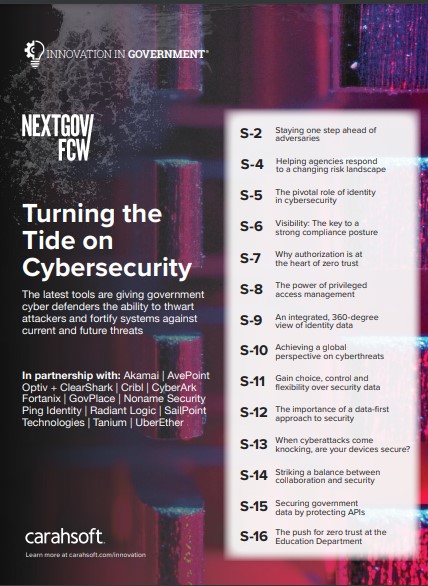Innovation in Government® Report
Turning the Tide on Cybersecurity
Cybersecurity is a never-ending battle to achieve supremacy over a variety of attackers who are constantly honing their skills and probing for vulnerabilities. Government agencies must secure all elements of increasingly complex and far-flung networks — from the edge to the core — and mitigate risks whether they arise in the cloud, on employees’ devices or in on-premises servers.
Threats have grown exponentially as agencies have moved more activities and data online and into the cloud and as cybercriminals and nation-state actors have become more brazen and sophisticated in targeting U.S. government systems, whether directly or through third-party systems.
Many emerging technologies that promise to improve the digital world also threaten to undermine efforts to protect government systems. For example, advances in quantum computing will lead to faster data processing and decision-making, but experts have long warned that adversaries could use the technology to break encryption algorithms in the blink of an eye. A National Security Memorandum released in 2022 states that “the United States must prioritize the timely and equitable transition of cryptographic systems to quantum-resistant cryptography, with the goal of mitigating as much of the quantum risk as is feasible by 2035.”
In addition, the rapid expansion of artificial intelligence is proving to be a boon for both cybersecurity professionals and adversaries. The technology can be used to automate routine security tasks and analyze data to identify vulnerabilities more quickly. However, adversaries can use AI to supercharge their attacks.
The emergence of new technologies will always bring new vulnerabilities, but each challenge is an opportunity to build an even stronger defense. In the battle for security, the government can never stop looking for innovative ways to help agencies stay one step ahead of adversaries.
Read the latest insights from cybersecurity thought leaders, including
- Matt Topper, President of UberEther, details how identity and access management is a cornerstone of zero trust and secure digital transformation
- Frank Briguglio, Federal CTO at SailPoint, notes how gaining visibility and control over user access is essential for tackling the current challenges in cybersecurity
- Bryan Rosensteel, Principal Solutions Architect at Ping Identity, discusses how a modern identity, credential and access management infrastructure continuously verifies known users’ permissions
- James Imanian, Senior Director of the U.S. Federal Technology Office at CyberArk, explains how privileged credentials are essential to agency operations but need special protection from attackers
- Wade Ellery, Field CTO at Radiant Logic, highlights how making security decisions increasingly relies on complete and up-to-date information about users
- Rob San Martin, Vice President of Public Sector at Akamai, mentions that insights into worldwide security trends and incidents are a game-changer for securing government networks
- Edward Resh, Consulting Engineer at Optiv + ClearShark, breaks down how visibility and control over event logging are the keys to finding actionable data and complying with federal mandates
- Patrick Conte, Vice President and General Manager for the Americas at Fortanix, unpacks how a unified security platform augments a zero trust model to protect data across its life cycle
- Kyle Hopeck, Director of Federal Partners at Tanium, and Dan Reed, Senior Director of Technology at GovPlace, partner together to speak on how Tanium provides the real-time, accurate endpoint data and immediate control necessary for zero trust
- Timothy Boettcher, Senior Vice President and Head of GTM Strategy for North America at AvePoint, elaborates on how secure information sharing plays a vital role in employee collaboration and modern service delivery
- Doug Steele, Vice President of Federal Sales at Noname Security, discusses how stronger visibility and security controls for APIs can boost the government’s efforts to protect sensitive data
Read more insights from Carahsoft and our cybersecurity partners when you download the full report:
Read more insights from Carahsoft and our cybersecurity partners when you download the full report:
By supplying my contact information, I authorize Carahsoft and its vendors and partner community to contact me with personalized communications about their products and services. Please review our Privacy Policy for more details or to opt-out at any time.